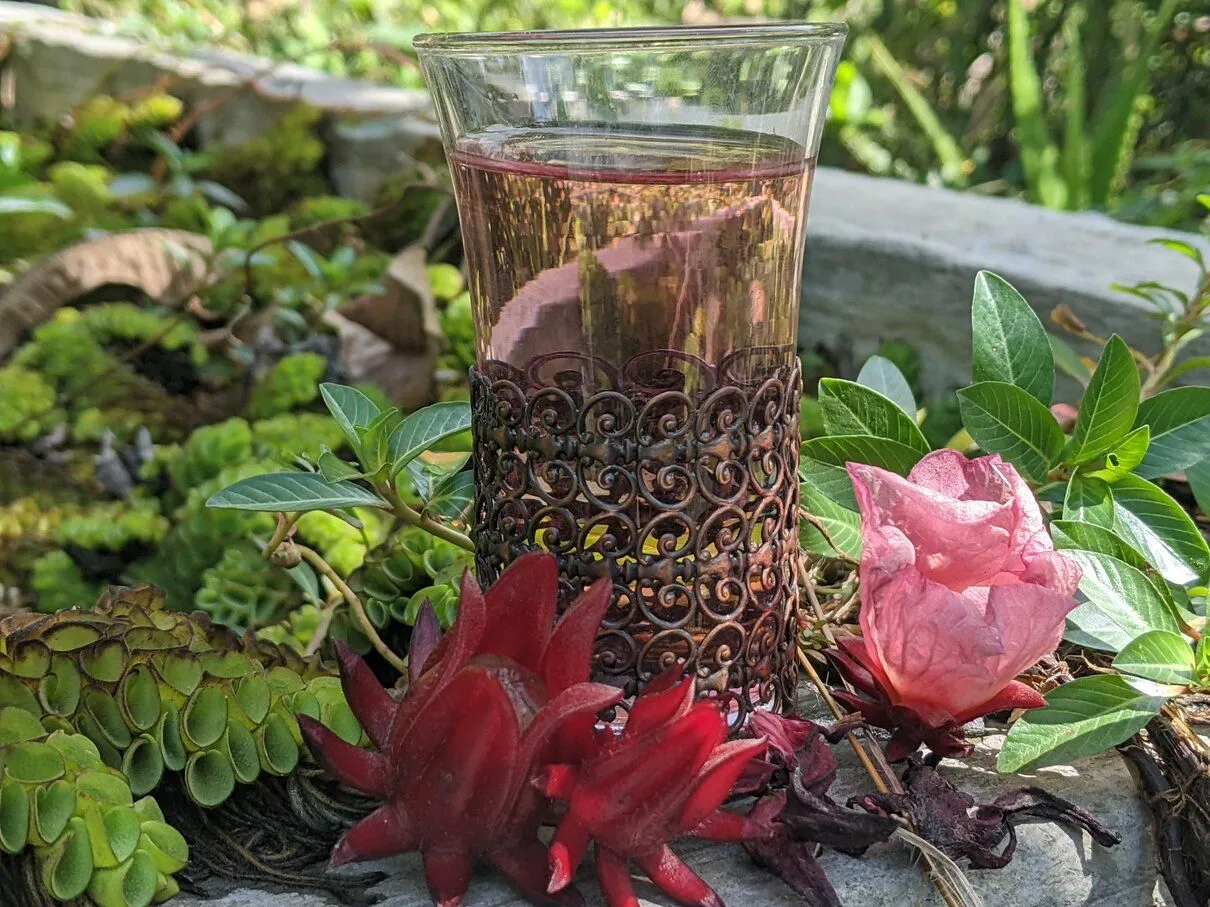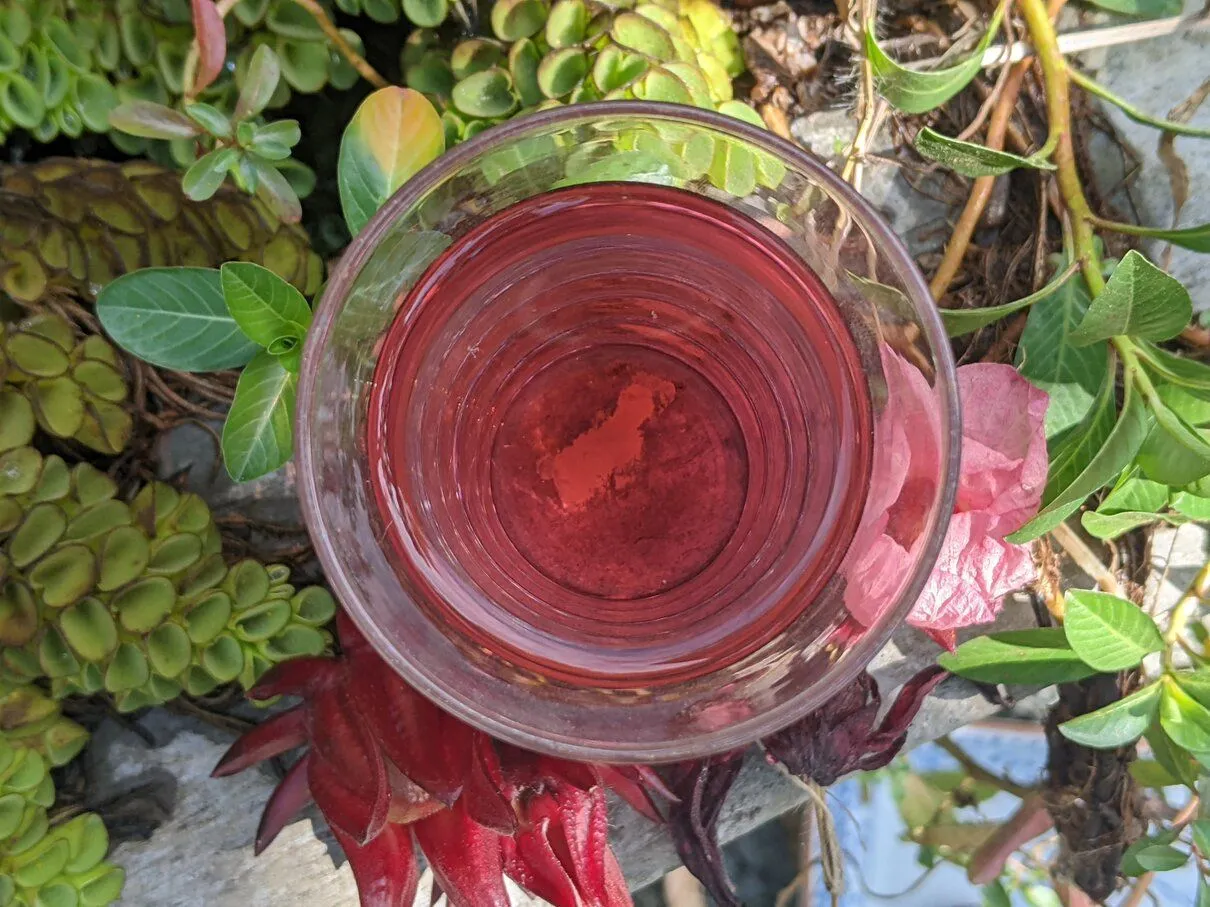
Don’t you just love how we have natural medicines growing around us? We just have to take the time to learn about them and get to know these plants. Going from weeds that grow without you having to do anything to plants you cultivate because of their beauty and/or flavor.
Hibiscus sabdariffa, or Roselle, is one of those plants we have in the garden because we enjoy its flavor in our tea. Plus, it is a very beautiful plant when it is flowering. Now it is that time of the year. In Cambodia Roselle hibiscus starts flowering when the days grow a little shorter. Though this difference is not a lot as we live close to the equator, mornings and evenings are just a little darker from November until January.
I have always been interested in natural healing. Recently, however, I took up a herbalist course to deepen my knowledge about the healing powers of plants. Ever since I am researching almost everything we have growing in the garden for its medicinal properties.
One of these plants is Roselle. Let’s take a look at what I’ve learned so far and how to harvest, dry the calyxes to make a healing cup of hibiscus tea.


Hibiscus sabdariffa - Red Sorrel - Roselle
Roselle is a shrub belonging to the Malvaceae family. The plant originates from Africa and Caribbean countries like West Indies, Trinidad, and Tobago. However, these days it is commonly found in tropical and subtropical regions in India and SE-Asia.
When you live in a subtropical or tropical region, Roselle is super easy to grow and produces so many seeds to quickly fill up your garden to make sure you can grow enough to provide you with a healing supply that will last a whole year. Or why not grow a few as a gift for family and friends so they can enjoy its beauty and healing properties too.
Roselle can be easily identified. It has bright red stems and a lot of appealing flowers which have a distinctive look. At every node, it produces a calyx.




Roselle uses
All parts of Roselle - including seeds, leaves, fruits, and roots - are used as an essential ingredient in various dishes from different parts of the world. Some people like to use the calyxes to make a lovely, bright-colored roselle juice. In some parts of the world the leaves are used in salads. Some compare their flavor to something like spicy spinach mixed with some sour fruitiness.
When I make tea I prefer to use the dried calyxes as they have a stronger flavor and you need to useless. But tea made with fresh ones tastes very nice too.
Furthermore, its bast fibers can be extracted from the stem to be used as a substitute for jute. The roselle plant is also quite popular in the beauty and skincare world due to its beneficial antioxidants to fight premature skin aging. You can find it in many body/facial scrubs, facial steams, clay masks, etc.

Nutrionla value
Roselle has various medically important compounds called phytochemicals. It is well known for both its nutritional and medicinal properties. Roselle is rich in organic acids including citric, malic, tartaric, and allo-hydroxycitric acids. The plant is also known for its beta-carotene, vitamin C, and protein levels.
Red calyxes are rich in carotene, riboflavin, anthocyanins, ascorbic acid, niacin, calcium, iron, and vitamin C. The young leaves and tender stems of Roselle can be eaten raw as a green vegetable. The Roselle seeds are a good source of protein, fat, and complex sugars.

Roselle as a herbal medicine
While roselle has been used as a therapeutic plant for centuries, up until now we only used it to flavor our tea. After doing a little research, we are now harvesting and drying the calyxes to add them to our natural medicine cabinet.
In folk medicine, roselle has been used for its mild laxative and diuretic effect. It has a cooling effect on the body. So it makes the perfect iced tea to conquer Cambodia’s tropical heat. It can treat cracked feet, bilious, sores, and wounds.
Roselle leaves possess antimicrobial, emollient, antipyretic, diuretic, antihelmintic (antiparasite), and sedative properties. It can be used to soothe a cough or ease menstrual pains.
Furthermore, science has shown that roselle has anti-insulin resistance properties and may help lower cholesterol and high blood pressure. It improves lactation and drinking a cup of hibiscus tea after meals can reduce the absorption of dietary carbohydrates and assist in weight loss. Extracts from Roselle are also known to have an effect on inflammatory diseases and cancer.
Source: Nutritional and health importance of Hibiscus sabdariffa: a review and indication for research needs - published in the Journal of Nutritional Health and Food Engineering.

Harvesting and processing hibiscus for tea
Though I am researching other ways to make use of this healing plant, for now, we are mainly drying the calyxes to make hibiscus tea.
Once the flower has fallen off, wait for another 7-10 days before harvesting. The calyxes will grow nice and fat.




If you let them on the plant a little longer the seeds will mature. Instead of a green seedpod, the pods will be dry and brown. One pod produces many seeds… I haven’t counted them but I think there are at least 20 seeds in one pod.




Peel off the calyxes from the seed pods. To make hibiscus tea you want to keep the bright red calyxes. Seeds can also be used in medicinal preparations.


Then you can either use them fresh to make tea or dry them in a dehydrator or use a drying net as we do. If using a drying net you can hang it up outside in the sun to speed up the drying process or inside in a well-ventilated room. We are drying inside as humidity has still been high even though the rainy season is over, we had a lot of rain during the nights the past few weeks.



When dried, store in an airtight jar or container.


Enjoy your tea hot or cooled in the fridge to make iced tea. I like my tea hot but the other week I made about 5 liters of hibiscus tea and 5 liters of my famous lemongrass and pandan tea to serve as a refreshing cooling drink at our garden cookout party. My friends liked both very much.

This is the amount I use for 1 pot of tea (1L). I think it's about 1-2 tablespoons, uncrushed.






WISHING YOU ALL A HAPPY AND HEALTHY DAY ღ ღ ღ

ALL CONTENT IS MINE AND ORIGINAL!
PICTURE(s) TAKEN WITH GOOGLE PIXEL 3 XL
LET'S CONNECT!
🥑🍓🍆 FIND MORE YUMMY PLANT-BASED CREATIONS BELOW 🥑🍓🍆
HOMEMADE VEGAN DOUBLE CHOCOLATE ICE CREAM - DIY ICE CREAM PART II
VEGAN VANILLA CHOC ICE CREAM - THE GOOD, THE BAD, AND THE ASKING FOR HELP